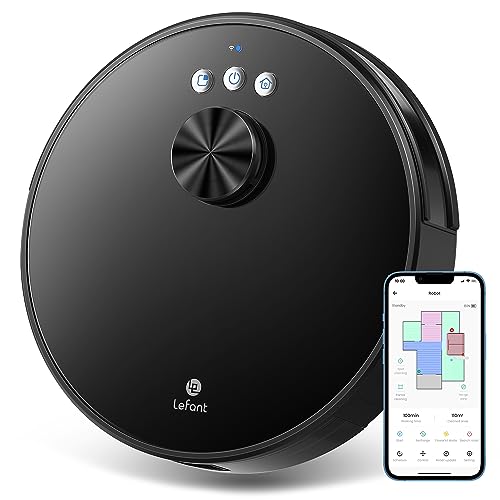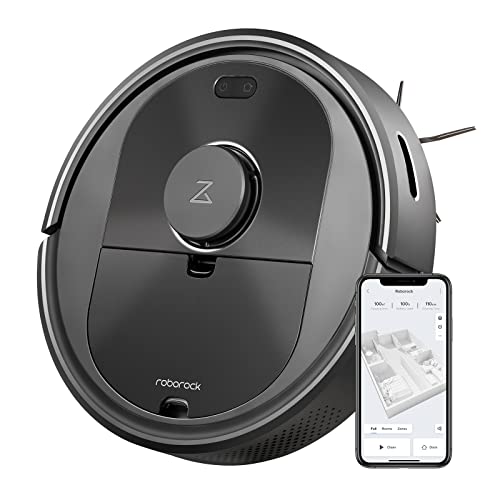Lidar Mapping Robot Vacuums
Lidar mapping robot vacuums utilize laser light to create an accurate map of the cleaning space. This allows them to move more thoroughly and effectively, without crashing into objects.
This advanced technology has influenced market trends as well as consumer preferences, with many customers choosing robotic cleaners that provide efficiency as well as precision and adaptability.
Precision and Accuracy
 Lidar is a vital technology that allows robots to navigate in the home. It allows them to avoid collisions and other obstacles. The system utilizes a laser-based sensor that sends out an impulse and then determines the time for the pulse to bounce back an object to determine its distance from the robot, forming an 3D map of the space. This allows the robot to draw an obstacle-free path and efficiently cover a space without omitting anything. Lidar is a vital technology that allows robots to navigate in the home. It allows them to avoid collisions and other obstacles. The system utilizes a laser-based sensor that sends out an impulse and then determines the time for the pulse to bounce back an object to determine its distance from the robot, forming an 3D map of the space. This allows the robot to draw an obstacle-free path and efficiently cover a space without omitting anything.
This method is more efficient than navigation systems that rely on infrared and ultrasonic sensors, which rely on soundwaves. The sensor can detect solid objects, or even dust specks on a floor. It also has a high level of accuracy, which makes it less likely to hit furniture or other objects around the home.
A lidar is also able to work in dark and bright environments which allows the robot to function at different levels of light. Sensors also allow robots to sense changes in the environment, such as furniture moving or adding new items. This information is used by the robot to modify its actions and facilitate an easier cleaning process.
A robot that is equipped with lidar also has the ability to detect edge detection. This feature helps it to prevent falls down stairs and other large differences in levels. This reduces the chance of damage to the vacuum cleaner or the home. It also makes the robot safer for children and pets who may run into it.
Other navigation systems like cameras or gyroscopes could also be useful in the context of robot vacuum cleaners. However, these technologies aren't as precise in comparison to the laser-based sensor that is found in lidar robot vacuum. They can also require more setup and calibration for optimal performance.
Many people decide to invest in a robot vacuum cleaner that has lidar navigation due to these reasons. While the cost of a device with this technology might be a bit more expensive than those that employ other navigation techniques, the benefits are significant.
Reduced Collision Risks
If you're in search of a robot vacuum that is more furniture-friendly look into one that has lidar navigation. This technology reduces the likelihood of collisions, and also protects your furniture from being scratched. It also makes it easier for robots to move through cluttered areas, without bumping into furniture or other obstacles.
Lidar technology makes use of lasers to scan an environment and detect reflections of objects to create 3D maps of the room. This lets the robot know where obstacles are located and navigate around them with pinpoint accuracy. The sensors are less likely to be confused by shadows or different colors than cameras, making them a great choice for use in rooms with changing lighting conditions.
However, there are certain limitations when using this kind of sensor for navigation by robotics. For example, it can be difficult for the system to recognize reflective or transparent surfaces like mirrors or glass coffee tables. The laser signals emitted by this system can pass through these surfaces, and reflect back in a direction that is not detected by the sensor. This can cause the robot to mistakenly interpret these surfaces as being free of obstacles, which can cause damage to furniture and vacuum.
Other navigation systems, like gyroscopes, are often more effective than camera-based systems at making sure that collisions are avoided. They are also more affordable than systems that rely on lasers to make a map of the surrounding. However, they're not as precise or efficient in their navigation as systems that utilize lasers such as lidar and SLAM.
The mapping capabilities of robots equipped with lidar can help them clean more thoroughly. They can avoid bumping into furniture and obstacles by creating maps. They can also plan their route in advance, tracing forwards and backwards along the Y-shaped shapes.
If you're willing to accept the possibility of furniture being damaged it is possible to save money by purchasing a cheaper robot with sensors to avoid obstacles, such as infrared or ultrasonic. If scuffed furniture or scratches on your walls are unacceptable, look for models that has laser navigation.
Enhanced User Experience
Lidar technology improves the experience of users using robot vacuum cleaner lidar vacuum cleaners, by improving their navigation capabilities. The ability to create a real-time map allows them to navigate through the house in a systematic manner while avoiding obstacles and covering the entire area. They are also better at navigation on carpets, and less likely to bump into furniture. They also perform well in dim lighting and can perceive transparent objects with greater accuracy than cameras.
Another benefit of lidar mapping is its ability to identify small obstacles, like cables and wires, which are hard to detect by other sensors, including ultrasonic and infrared ones. This lets them keep the cables from getting sucked up or tying them up with their wheels and is less likely to cause damage to important electronics.
Many robot vacuums offer the option of setting virtual walls or boundaries within the app, which can restrict the use of the device in certain areas of your home. This is especially helpful when there are precious electronic devices on or near the floor. This ensures that the cleaning process will not damage the electronics. This feature can also be used to prevent access to a specific room such as bathroom or bedroom.
While this feature is useful, it isn't completely secure and some robots might be able to enter these rooms. It is important to keep your sensor clean and free of debris, dust, and other contaminants in order to minimize this risk. The manufacturer's site or user manuals will give detailed instructions on how to clean the sensor and when it needs to be done.
 Lidar mapping can be affected by reflective surfaces, and it may have difficulty in identifying objects that are not opaque. Furthermore, the information generated by the sensor could be inaccurate, especially when it is affected by complicated room layouts or lidar mapping robot Vacuum the changing lighting conditions. Lidar mapping can be affected by reflective surfaces, and it may have difficulty in identifying objects that are not opaque. Furthermore, the information generated by the sensor could be inaccurate, especially when it is affected by complicated room layouts or lidar mapping robot Vacuum the changing lighting conditions.
Another drawback of lidar mapping is that it can be more expensive than other navigation techniques, such as cameras and infrared sensors. This is a major aspect when purchasing an expensive robot vacuum cleaner, especially for those with a tight budget. It is nevertheless expected that ongoing technological advancements will lower the cost of robot vacuum cleaners, making them more accessible to a wider audience of consumers.
Future Developments
Lidar technology is a game-changer for robot vacuums, elevating them to intelligent, flexible household pets that can operate efficiently in your home. However, challenges remain. lidar mapping Robot vacuum (hinton-shore-2.thoughtlanes.net)-equipped robotics are usually more expensive than those with simpler navigation systems. The cost of lidar based robot vacuum-equipped robots is likely to decrease as manufacturing techniques and sensor miniaturization continue to improve.
Furthermore, advanced mapping systems that depend on Lidar can help robots identify objects and navigate around them more effectively than systems that use simple sensors, like infrared or laser sensors, to map the environment. Furthermore the precise detection capabilities of lidar can assist robots in identifying small objects that other sensors might miss. This lets them avoid them or adjust their route to avoid them. They will then be able to navigate more efficiently in your home and avoid areas that require cleaning.
Choose a robot vacuum with a furniture-friendly interface when you are looking for one that uses Lidar. This feature guarantees that your vacuum will not be blocked by items such as socks and slippers when cleaning. This feature also helps prevent the robot from falling off of stairs or ledges. Furthermore, a furniture-friendly vacuum comes with edge detection capabilities that can assist in avoiding hitting or damaging furniture.
A lidar robot vacuum should also be able detect corners and stair edges. This is particularly important in homes with multiple floors or Lidar Mapping Robot Vacuum if you live in a multi-story apartment. The robot can sweep your entire home. Lidar's edge detection abilities can also stop it from falling off stairs or ledges.
Other cutting-edge features that you should look for in a robot vacuum include 3D structured light obstacle avoidance, binocular or monocular vision based obstacle avoidance, and omnidirectional camera based navigation. These technologies can all create convenience with a variety algorithms that allow the robot to navigate and avoid obstacles with greater precision and effectively. It is important to keep in mind that, despite the high-tech nature of these technologies, they all require maintenance in order to function efficiently. This is due to the fact that all of them depend on sensors to function, so these sensors need to be free from dust and other particles for them to function properly.
|